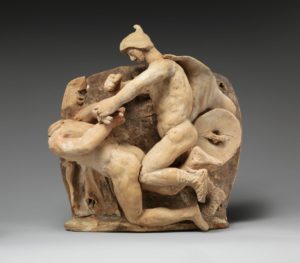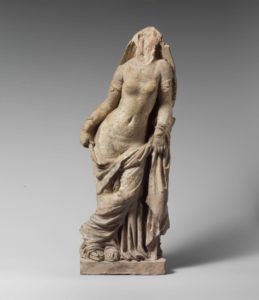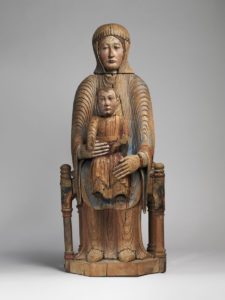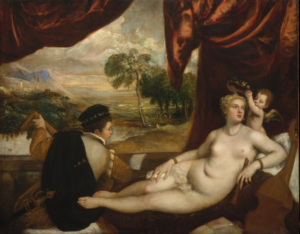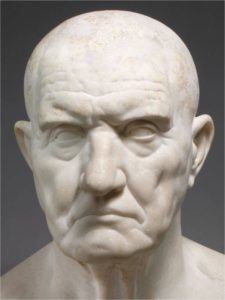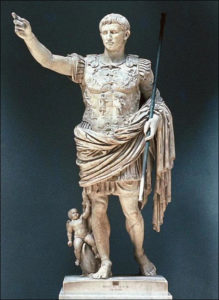Walk in the Paths of Devotion
A Virtual Museum Tour Through Ancient Artworks
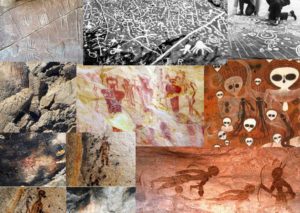
Divya Roy
Table of Contents
What is devotion…………………………………………… 1
Ancient Mesopotamia………………………………………………………………. 2
Ancient Egypt………………………………………………………………………… 3
Ancient Greece……………………………………………………………………….. 4
Ancient Rome………………………………………………………………………… 5
Renaissance…………………………………………………………………………… 6
What is Devotion
Devotion can be interpreted to mean a lot of different things. It is a form of “love, loyalty, or enthusiasm for a person, activity, or cause” or in a religious perspective, devotion is to a deity, practiced through religious worship, prayers or religious observances. Art, especially ancient art, is a window through which one can see this psyche of people and the propensity of their devotion to a particular deity.
The art made by the artists is in fact a form of devotion, as the elements give so much depth about the subject and the artist. Art is a form of devotion, such that when art changes so does devotion.
The MUSEUM TOUR
This museum tour will focus on multiple works of art from different eras and places in a journey to understand and get a grasp of the psychology behind devotion for the ancient peoples and its creators.
“True devotion is motivated by love alone and devoid of selfish entanglements.”
Indeed, there is no doubt that the works of art we will see today are made in devotion to the Gods of the time, a portion of love alone and devoid of selfish entanglements, as the art works speaks volumes through the intricate work about struggles and selflessness of the creators.
MESOPOTAMIA
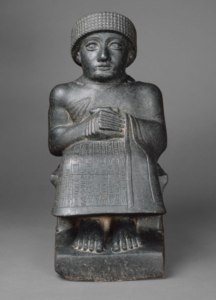
Period: Neo-Sumerian
Date: ca. 2090 B.C.
Place: Mesopotamia
Classification: Stone-sculpture-inscribed
The work from a visual perspective tells of an important and revered subject. The subject in the statues is Gudea, a ruler of the state of Lagash. The statue demonstrates a very sophisticated level of craftsmanship for the time and even today. The inscription details the story of Gudea, and how the statue is dedicated to honor the Gods/goddesses by being placed in a temple. Each of the very fine detailing of stone, form the hat, to the fingers/toes and the inscription is telling of the value of this particular artwork. This is almost an offering to the Gods, as the art is sought to represent divinity and the craft something more than the natural.
EGYPT
For ancient Egyptians, the ideal pharaoh was a man in his young adulthood and in the prime of his life however, physical reality often tended to be less important as old men, women, or even babies who have the title of pharaoh could be viewed in this very ideal form. Therefore, the visual image especially portrayed in artworks becomes a relevant part of devotion. The representation of of the female Hatshepsut shows exactly that. The inscriptions for her depicted her with masculine and feminine grammar even though it states she is a woman.
This statue was one that stood in the grand doorway on the upper terrace of Hatshepsut’s temple.

Period: New Kingdom
Date: ca. 1479-1459 B.C.
Place: Upper Egypt
Greece
Ancient Greece was probably one of the more widely recognized civilizations for their devotion to the supernatural, as they worshipped multiple Gods, each with a distinct character and quality. The Hellenists, like many ancient civilizations used there Gods as a way for making sense of the chaos in the world, and form an origin for human life.
The most intriguing aspect of devotion in my perspective is that, the Greeks were able to form devotion through the mundane. In a sense incorporating religion and devotion into their everyday life, so much so that they are constantly reminded of it in every part of their day. Below is a simple vase depicting the story Perseus being sent to obtain the head of Medusa by King Polydektes.

Period: Classical
Date: 450-440 B.C.
Place: Attic Greece
Classification: Vases
ROME
The ancient Roman era gives a different portrayal in devotion. The deities become dramatically similar in physiology to human beings. The devotion though still to a deity, shifts to the ideal image of human beings. The musculature and bone structure become highly emphasized for the ancient Romans. In a sense, this marks the beginning of a human superiority complex, and devotion starts to become self-centered. Because artists were able to portray the human body so keenly, the devotion toward the “human” becomes even more stronger. The athlete’s body was highly idealized and emphasized during this time.
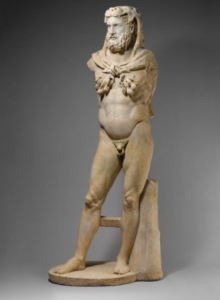
Name: Marble Statue of Bearded Hercules
Period: Early Imperial, Flavian
Date: 68-98 AD
Classification: Stone sculpture
RENAISSANCE
During the time of Renaissance, devotion becomes more focused and organized, as Christianity starts to take root among the people. People looked to a man named Jesus Christ as their savior. Because of Jesus’ narrative, paintings came of real value and emotion, like all other arts discussed. Jesus’ story became a center of focus, as it was so painful, touching and moving. Every aspect of Christ’s life was poured out into paintings. Especially, his climatic moments on Earth, were emphasized. The last supper became a symbolic element of the church to come together in communion and join the community in a union even after the leader’s death. The painting of the last supper became an emblem for community and worship.

Name: Last Supper
Date: 1325-30
Place: Italy
Classification: Painting
Annotated Bibliography
Ziegler, Joanna E. “Michelangelo and the Medieval Pietà: The Sculpture of Devotion or the Art of Sculpture?” Jstor, 1995, www-jstor-org.ez-proxy.brooklyn.cuny.edu/stable/pdf/767122.pdf.
This article focuses on how reacting to Flemish models Michelangelo remained consistent in his views of art. He radically redefined the enterprise of the sculpture and sculpture making and also art itself. He did so by making the sculptures inviolable (due to the change of material from wood to marble) and resistant to the physical transformations. I particularly took interest in this article because it was seen that the Flemish works have been associated with devotion and in ritualistic proceedings. This transformation in art as a consequence of Michelangelo explores how devotion becomes tested when art transforms.
“IWonder – Why Does the Art of Ancient Greece Still Shape Our World?” BBC News, BBC,2017www.bbc.com/timelines/z99tn39.
This research site goes into the specific of Greek art in chronological time while incorporating with its history. And we see, that Greek art often becomes a reminder for future generations about previous generations, it was a way of carrying down legacies. This is why art is important to the Greeks. Ancient art especially carries down the traditions of ancient Greek people, and allowing them to overwhelmingly present in everything gives a constant reminder to Greeks about who they are and who they were.
“Renaissance Art.” History.com, A&E Television Networks, 1 Jan. 2018, www.history.com/topics/renaissance/renaissance-art.
This website really helped to give a full understanding of Renaissance art and especially why it was important in Christianity. This helps draw the importance of Christ in almost all of Renaissance paintings and other artworks. The role serves a bigger purpose to unite the Christian community.
“Hatshepsut.” The Met’s Heilbrunn Timeline of Art History, 2010, www.metmuseum.org/art/collection/search/544446.
This website explores why gender was not an issue in Egyptian art work as their idealized figure always remained universal in all of the artworks. This becomes an important aspect in devotion as the role or title of pharaoh was to be devoted to rather than the individual identity.
NĂSTĂSOIU, DRAGOŞ GH. .. “Patterns of Devotion and Traces of Art.” Umeni / Art, vol. 64, no. 1, Jan. 2016, pp. 29–43. EBSCOhost,ezproxy.brooklyn.cuny.edu:2048/login?url=http://search.ebscohost.com/login.aspx?direct=true&db=aft&AN=114579735&site=ehost-live
The article provides an analysis of art history and patterns of devotion by referring to the pilgrimage of Queen Elizabeth Piast to Marburg, Cologne, and Aachen, Germany in 1357. Following the journey, the reader becomes convinced that there is infact a connection between art and devotion and two are inseparable.






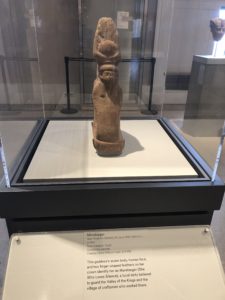
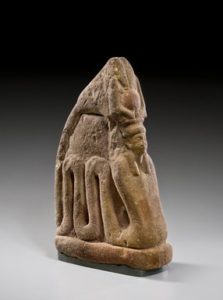
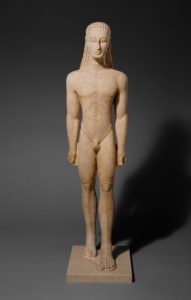

 Take a look at the wreath, this piece belongs to the ancient Egyptians, the wreath is made with gold and was used to crown athletic victories throughout the ancient Greek time. This shows the symbol of victorious men’s through their accomplishment, and not only was this used during the Egyptian times; it was also used during the Hellenistic period.
Take a look at the wreath, this piece belongs to the ancient Egyptians, the wreath is made with gold and was used to crown athletic victories throughout the ancient Greek time. This shows the symbol of victorious men’s through their accomplishment, and not only was this used during the Egyptian times; it was also used during the Hellenistic period. 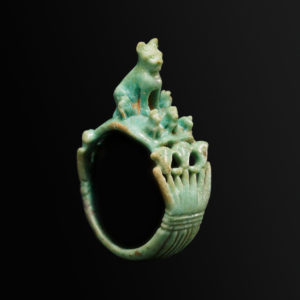 The Ring of Cat and Kittens is used to symbolize as the “faraway goddess”, the cat is supposed to be a deity that ran away from the Nubian Desert and had to go back to the Nile Valley. This symbolism is to bring prosperity back to Egypt. Rings like this are most likely created to celebrate various festivals in honor of the deities depicted on the rings.
The Ring of Cat and Kittens is used to symbolize as the “faraway goddess”, the cat is supposed to be a deity that ran away from the Nubian Desert and had to go back to the Nile Valley. This symbolism is to bring prosperity back to Egypt. Rings like this are most likely created to celebrate various festivals in honor of the deities depicted on the rings. 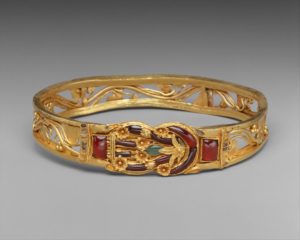 The Gold armband with Herakles knot is a gold bracelet inlaid with emeralds, enamel, and garnets. It was believed that any Hellenistic jewelry with a Herakles knot was known to have the power to thwart evil and cure wounds.
The Gold armband with Herakles knot is a gold bracelet inlaid with emeralds, enamel, and garnets. It was believed that any Hellenistic jewelry with a Herakles knot was known to have the power to thwart evil and cure wounds. 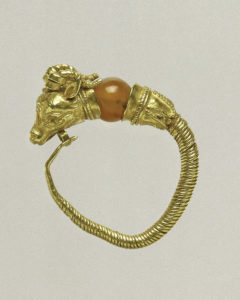 This is a goat head earring during Hellenistic times. During the Ancient Greek time, they believed the goat is closely related to one of their God Dionysus later known as Bacchus in the Roman period (the god of wine and fertility). It was believed that the goat was related to men, and it was associated with burning sexuality and lasciviousness and lust. Since jewelry was made for mainly women and was used to appeal to the opposite sex, you can say that this goat earring is made to attract males to females, and to show that they can be fertile.
This is a goat head earring during Hellenistic times. During the Ancient Greek time, they believed the goat is closely related to one of their God Dionysus later known as Bacchus in the Roman period (the god of wine and fertility). It was believed that the goat was related to men, and it was associated with burning sexuality and lasciviousness and lust. Since jewelry was made for mainly women and was used to appeal to the opposite sex, you can say that this goat earring is made to attract males to females, and to show that they can be fertile.







